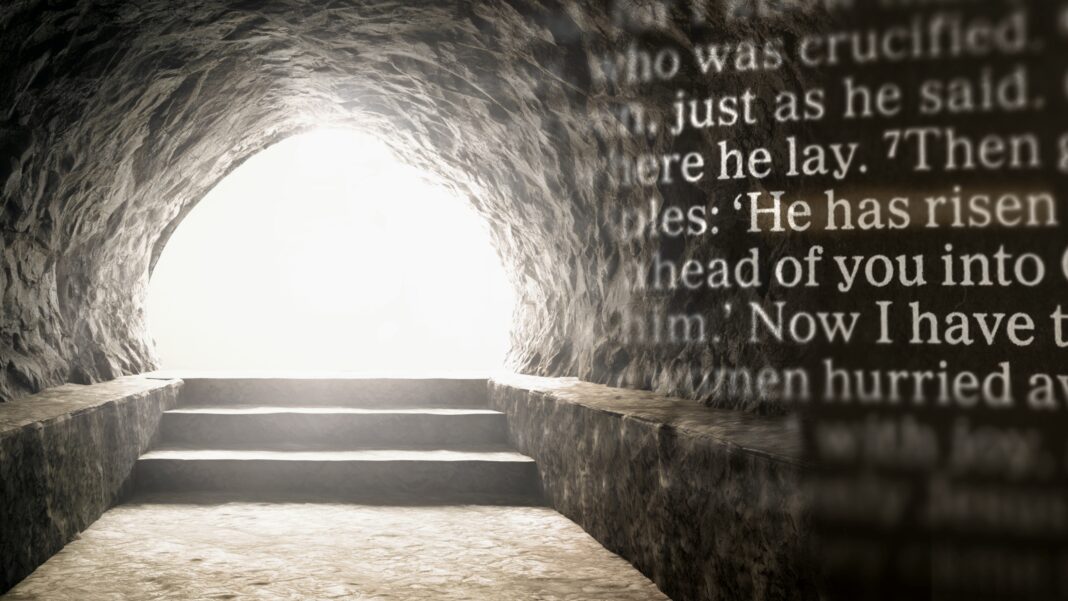Every year thousands of people travel to the Italian Alps to ascend a mountain which passes through the “stations of the cross.” Eventually, they come to the foot of an outdoor crucifix. One day a tourist noticed a trail leading away from the cross. Determined to find out where it would lead, he fought through all the thicket that surrounded the path; and to his surprise, he came to the next shrine—a shrine that symbolized the empty tomb. But the brush had grown up around it; it had been neglected. Almost every visitor that passed through had gone as far as the cross—but there they stopped.
The same is true for many in our world today. Even people who go to good churches where the Bible is taught and where they believe in Jesus have come to believe that the crucifixion of Jesus Christ is the key element in the story of the Gospel. Not to diminish the cross, because the cross is critically important, but if Jesus Christ simply died and was buried and did not come back from the grave, then He could not be the Savior of the world any more than you or I can. But if Jesus came back from the grave, He has made a statement worth listening to.
I grew up in a Christian home, and I’ve been to many Easter celebrations in my lifetime. My father was a preacher, and he was a good teacher, but I did not have a full understanding of the priority of the Resurrection until I was a second-year student in seminary. I was invited to attend a dinner that was being hosted in our area for people who wanted to know more about the Gospel and about Jesus Christ.
The speaker at that dinner happened to be one of my professors, a man by the name of Haddon Robinson. I went to the dinner expecting him to talk about the crucifixion and the death of Christ; but to my surprise, he made a presentation of the Gospel looking at the cross through the open tomb. He spent the entire evening giving evidence for the Risen Christ.
And for the first time it dawned on me: If a person doesn’t understand the Resurrection, or doesn’t believe in the Resurrection, it’s very difficult to come to grips with the power of the Gospel.
So the issue at hand is this: How do we know the Resurrection is a credible event that actually happened? And can it be supported by evidence?
As we journey through the account of the Resurrection as found in the Gospels, we’ll identify seven crucial signs demonstrating that Jesus Christ did indeed rise from the dead.
The Signs.
What they found that day has forever changed the nature of our world.
The story begins in Matthew 27. The crucifixion of Christ has taken place. Joseph of Arimathea and Nicodemus, two very wealthy men, have claimed the body of Jesus and have buried His body in a tomb in which no corpse had ever lain before. On the third day after His death, some visitors came to the tomb—and what they found that day has forever changed the nature of our world.
The Soldiers.
Imagine that we were privileged to be the first ones to visit the tomb, and that we, along with the visitors who did go there, were able to approach the garden where Jesus had been buried.
Upon our arrival at the tomb, the first sign we would have noticed is that there were no soldiers. This is peculiar because soldiers had been stationed to guard the tomb for at least the first three days following Jesus’ crucifixion. Why? Jesus had claimed that He would come back from the dead, and the Jewish authorities wanted to make sure that if His body went missing, no one could say He had risen from the grave.
In Matthew 27:62-66 we read these words: “Now the next day, that followed the day of the preparation, the chief priests and Pharisees came together unto Pilate, Saying, Sir, we remember that that deceiver said, while he was yet alive, After three days I will rise again. Command therefore that the sepulchre be made sure until the third day, lest his disciples come by night, and steal him away, and say unto the people, He is risen from the dead: so the last error shall be worse than the first. Pilate said unto them, Ye have a watch: go your way, make it as sure as ye can. So they went, and made the sepulchre sure, sealing the stone, and setting a watch.”
A Roman guard unit consisted of sixteen soldiers. Usually, four of them would stand side by side in front of the object they were guarding and the other twelve would gather in a semi-circle behind them facing inward. While the four were guarding, oftentimes the other twelve were sleeping. And every four hours, the soldiers who were standing in front of that which they guarded would take their place in the circle and four fresh soldiers would stand guard.
It was a very formidable thought that sixteen Roman soldiers were guarding the tomb. But when the women arrived that morning, there were no soldiers. Something happened to explain their absence. Matthew 28:11 says, “Now while they were going, behold, some of the guard came into the city and reported to the chief priests all the things that had happened.”
What had happened? The tomb was empty. Jesus was gone.
Matthew 28:12-15 KJV – “And when they were assembled with the elders, and had taken counsel, they gave large money unto the soldiers, Saying, Say ye, His disciples came by night, and stole him away while we slept. And if this come to the governor’s ears, we will persuade him, and secure you. So they took the money, and did as they were taught: and this saying is commonly reported among the Jews until this day.”
Although the idea that the disciples stole the body of Jesus explains the missing body, the idea is illogical for at least two reasons: First, it is impossible that the soldiers would have all slept through the disciples moving the stone away from the mouth of the tomb and stealing the body of Jesus.
In fact, twelve of them could have been sleeping, but four of them were supposed to be awake. And the real conundrum is this: If the soldiers were all asleep, how did they know who stole the body?
The Seal.
As we get closer to the tomb itself, we notice that the stone is missing, but along with the missing stone is the missing seal.
The Bible tells us that they “made the tomb secure, sealing the stone and setting the guard” (Matthew 27:66). After the stone was rolled in place, a rope was stretched across the stone and affixed with wax to each side of the sepulcher, the tomb. Then the Roman guard would put his signet ring in the wax, signaling that the sepulcher was officially sealed and contained what was purported to be inside. But when the women came to the tomb on that first Sunday, the stone had been rolled away, so the seal had been broken.
Matthew 27:65-66 KJV – “Pilate said unto them, Ye have a watch: go your way, make it as sure as ye can. So they went, and made the sepulchre sure, sealing the stone, and setting a watch.”
The Stone.
But surely the most startling sign the visitors noticed when they stood outside Jesus’ tomb must have been that the stone that had covered the entrance of the tomb was missing.
When they would seal a sepulcher, a tomb, in the days of Jesus, the body of the deceased was placed inside a hewn-out stone (the sepulcher) and then a piece of granite, usually in a round form, was rolled in front of the mouth of the tomb to keep animals from desecrating the corpse and to protect the dignity of the buried person. In front of the tomb they would create a groove, an incline, and they would roll the stone up the incline and put a shim under it. After the burial, they would roll the stone in front of the grave and seal it to officially close the sepulcher.
But when the women came to the garden that day, there was no stone in front of the tomb. In fact, the Scripture is very explicit about what had happened: “Mary Magdalene and the other Mary came to see the tomb. And behold, there was a great earthquake; for an angel of the Lord descended from heaven, and came and rolled back the stone from the door, and sat on it” (Matthew 28:1-2).
And as we read the other Gospel accounts, we gain an even clearer picture of what happened that day. Mark tells us this stone was extremely large—actually, a stone which twenty men could not move. And John’s gospel tells us that when John ran to the tomb, he had to bend over to look inside.
Scholars believe that the tomb in which Jesus was buried had an opening about four and a half feet to five feet high. In fact, several studies have been conducted to determine how large the stone would have been in order to cover such an opening, and the conservative estimates indicate that the stone would have weighed in at one and a half to two tons.
But when the women got there that day, the stone was not in front of the opening, and it wasn’t even in the groove that had been placed there to help move the stone. John says “the stone had been taken away from the tomb” (John 20:1). And the words John uses to describe the displacement of the stone mean “to pick something up and carry it away.” So the stone hadn’t been merely rolled back up the incline where it had started; it wasn’t near the opening of the grave. Rather, the stone was over by itself, as if someone had picked it up and moved it over. And then, of course, there was an angel sitting on top of it (Matthew 28:2). Obviously, something miraculous was going on that day.
The Sepulcher.
Examining the tomb of Jesus, we discover the fourth sign of the Resurrection: the sepulcher itself.
When we study Luke’s account, we read that not only did the women find “the stone rolled away from the sepulchre. And they entered in, and found not the body of the Lord Jesus. And it came to pass, as they were much perplexed thereabout, behold, two men stood by them in shining garments: And as they were afraid, and bowed down their faces to the earth, they said unto them, Why seek ye the living among the dead? He is not here, but is risen: remember how he spake unto you when he was yet in Galilee,” (Luke 24:2-6).
When they looked inside the tomb, there was no body. Past the soldiers, past the seal, past the stone, and in the security of the sepulcher—Jesus’ body was gone.
The Shroud.
The evidence is growing, and we still haven’t come to the most powerful evidence of all.
When Peter and John looked into the grave that day, the tomb was almost empty, but not quite. No, there wasn’t a body, but there was a shroud—the grave clothes were still there.
John 20:3-8 says: “Peter therefore went forth, and that other disciple, and came to the sepulchre. So they ran both together: and the other disciple did outrun Peter, and came first to the sepulchre. And he stooping down, and looking in, saw the linen clothes lying; yet went he not in. Then cometh Simon Peter following him, and went into the sepulchre, and seeth the linen clothes lie, And the napkin, that was about his head, not lying with the linen clothes, but wrapped together in a place by itself. Then went in also that other disciple, which came first to the sepulchre, and he saw, and believed.”
In Jesus’ day, people weren’t buried in robes; they were buried in layers of fabric, similar to what we would think of as a mummy, with spices wrapped between each layer of cloth. And as Peter and John peered into the grave where Jesus’ body had lain, they saw something startling—there were the grave cloths that had encased Him, still in the shape of His body, slightly indented and caved in, like the empty chrysalis of a caterpillar’s cocoon. That was enough evidence to make a believer out of anyone. And the Scripture says that when John peered into the tomb and saw the empty grave cloths—undisturbed in their form and position—he believed.
I don’t know exactly how their conversation went, but John’s explanation to Peter must have gone something like this:
Don’t you see, Peter? No one has moved the body or even disturbed the grave cloths. They’re lying exactly as Nicodemus and Joseph of Arimathea left them on the eve of the Sabbath. And the body is gone. It hasn’t been stolen. It’s not been moved. Clearly, His body had to have passed through the cloths, leaving them as we see them now. Jesus must be risen!
Theologian and teacher James Montgomery Boice commented on this fact:
This sign of Easter destroys the idea that the body was stolen. The linens would not have been there. This sign destroys the idea that Jesus resuscitated Himself and walked out of the grave. Leaving the grave clothes in the shape of His body in the tomb? A glance at these grave clothes proved the reality of the Resurrection.
Following that experience, instead of being cowardly, as they were before the crucifixion, John and his fellow disciples became courageous evangelists for the Gospel.
In fact, the Bible says that as a result of the Resurrection, these men of God turned their world upside down. And if you read the book of Acts, which is the history of the early church, and the sermons that were preached by the apostles at that time, you’ll notice that the Resurrection is the theme of every one of their messages.
They were changed dramatically by what they saw that day when they went into the tomb.
The Scars.
Now let’s examine what happened in the days that followed. The Bible tells us that after the Resurrection, there was an occasion when Jesus’ apostles were gathered in the Upper Room and Jesus appeared to them. The Bible says He did not come through the door; He just appeared. (Remember, Jesus was in His resurrection body.) But one of the disciples, Thomas, was not present. After the meeting the disciples told Thomas that they had seen the Risen Lord; but unbelieving, Thomas said, “I won’t believe it until I see it myself.”
Eight days later, the Lord returned, but this time Thomas was among the disciples:
John 20:26-28 KJV – “And after eight days again his disciples were within, and Thomas with them: then came Jesus, the doors being shut, and stood in the midst, and said, Peace be unto you. Then saith he to Thomas, Reach hither thy finger, and behold my hands; and reach hither thy hand, and thrust it into my side: and be not faithless, but believing. And Thomas answered and said unto him, My Lord and my God.”
Thomas knew he had seen the Risen Lord because of the scars in Jesus’ body.
The Sightings.
Even beyond the scars, there is yet more evidence for our Risen Savior. Did you know that after He was resurrected from the grave, Jesus didn’t immediately ascend to heaven? He spent several days here on this earth. And during that time, we are told that Jesus was not only seen by the apostles on the two occasions in the Upper Room, but by men and women, by adults and children, by individuals and groups, in the morning and in the evening.
In every situation you can imagine, Jesus Christ was seen. In fact, if you read 1 Corinthians 15:6, Paul says that He revealed Himself on one occasion to more than five hundred people, most of whom were still alive at the time Paul wrote his letter.
Certainly, they could have refuted his statement had they chosen to do so. One writer has said that if all the witnesses who saw Jesus in His resurrected body were brought to court and given six minutes to speak, it would result in more than fifty hours of testimony about the Risen Christ.
The evidence for Christ’s resurrection is overwhelming! We can say with absolute certainty that Jesus Christ is alive. He overcame the grave. And He is living today at the right hand of the Father in heaven.
Three Reasons the Resurrection is Important Today.
Now that we have examined the signs of the Resurrection, we are left with but one question: Why is the Resurrection important today? What difference does it make?
Because He is risen, Christ affects every part of our life: past, present, and future.
Our Past.
Scripture tells us that we are separated from God because He is holy and we are not—we have all sinned and come short of the glory of God (Romans 3:23). We cannot measure up to His standard and we cannot get to heaven in our own imperfection.
But Almighty God devised a plan of redemption—He would send His only Son, Jesus Christ, to this world to live a perfect life, and He would ultimately go to the cross to pay the penalty for our sin.
Some wonder, How could one man do that? And the answer is: No mere man could, but this man was the Son of God. He was God in the flesh, and only through Him can we come to God fully justified. Jesus Christ Himself said, “I am the way, the truth, and the life. No one comes to the Father except through Me” (John 14:6).
Only by placing our trust in Him for the forgiveness of our sin can we go to heaven. And because Jesus Christ came back from the grave, demonstrating the reality of His words and the truthfulness of His statements, we know that His words are true.
Our Present.
Most people are surprised that the Resurrection has anything to do with the present, but the Bible tells us that because Jesus Christ died on the cross and rose from the grave, He now gives us the same power that was used to bring Him back from the dead so that we can live our lives every day in resurrection power.
Over and over again, we read that Jesus Christ has given us the power to live a special life. One especially encouraging passage, Ephesians 1:19-20, says, “What is the exceeding greatness of His power toward us who believe, according to the working of His mighty power which He worked in Christ when He raised Him from the dead.”
That means we have the same power available to us to live the Christian life that God used to bring Jesus Christ out of the grave.
We struggle when we try to live the Christian life in our own power, in our own strength. But if we will depend on the power of God for help, He will give us the strength and power. We’re sinful, but He saves us. He changes us from being cruel, mean-spirited, hateful people, and we discover a desire to be kind, and loving, and gracious. We’re lustful and immoral, and He takes those emotions and those desires and changes them by the power of God in us. We become different people.
The Bible says, “Old things have passed away; behold, all things have become new” (2 Corinthians 5:17). How does that happen? It happens because Almighty God comes to live within us and fills us with the power of the Resurrection.
Our Future.
Thirdly, not only does Christ’s resurrection affect our past and present, it’s the guarantee of our future.
Because Jesus rose from the grave, He became for believers the guarantee that, one day, if we should die before He comes back to this earth at the Rapture, we too shall come back from the grave.
The Bible says that Christ is “the firstfruits of those who have fallen asleep” (1 Corinthians 15:20). And in 1 Thessalonians 4:14-17 we read: “For if we believe that Jesus died and rose again, even so them also which sleep in Jesus will God bring with him. For this we say unto you by the word of the Lord, that we which are alive and remain unto the coming of the Lord shall not prevent them which are asleep. For the Lord himself shall descend from heaven with a shout, with the voice of the archangel, and with the trump of God: and the dead in Christ shall rise first: Then we which are alive and remain shall be caught up together with them in the clouds, to meet the Lord in the air: and so shall we ever be with the Lord.”
That’s the guarantee we have as believers, and it’s all hinged on the Resurrection of Jesus Christ. If Christ hadn’t come out of the grave, we would have no hope at all. We would die in despair; and many people die in despair today because they refuse the truth of the Risen Savior. But when we place our trust in the Lord Jesus and ask Him to forgive us of our sins, to save us and to come and live within our lives, we receive the gift of eternal life and the guarantee of heaven (Romans 6:23).
As Christians, we no longer have to fear death, because we have an incredible hope—the hope that one day we will be with God forever. And it’s not a “hope so” hope; it’s a “know so” hope.
1 Corinthians 15:55-57 KJV – “O death, where is thy sting? O grave, where is thy victory? The sting of death is sin; and the strength of sin is the law. But thanks be to God, which giveth us the victory through our Lord Jesus Christ.”
Conclusion.
The Resurrection is not just something we celebrate once a year at Easter with our families. The Resurrection is the most important doctrine of the Bible, because if Jesus didn’t do what He said He would do, which was to come back from the grave after three days, we can’t believe anything that He said.
But Jesus did what He promised He would do.
We have a unique Savior—unique in the fact that He came from God in His origin, unique in the fact that He was born of a virgin, unique because He lived a life without sin, and unique because He came out of the grave victorious over death. And the same uniqueness that is in Jesus Christ is available to all of us to help us live a life that honors Him. With Almighty God in our heart through Jesus Christ, we have victory: over our past, in the here and now, and for eternity.














